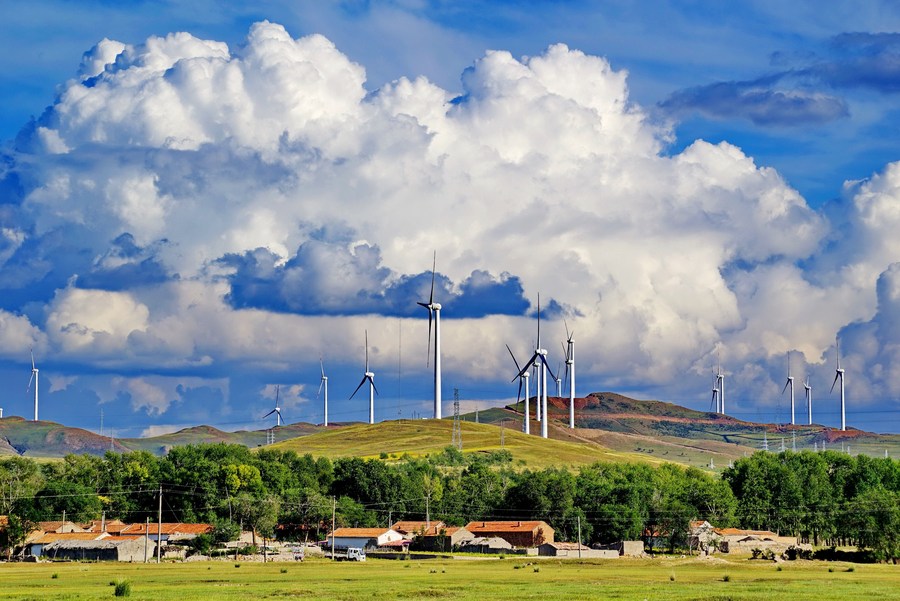Emissions goal to 'very likely' be achieved
Reducing reliance on fossil fuels such as coal is key step, professor says


China is "very likely" to hit its carbon emissions peak goal before 2030, paving the way for the country to become carbon neutral before 2060, experts said during an online seminar hosted by Tsinghua University in Beijing on Thursday.
This will require greater public-private partnership, new policies and innovations for promoting green development and effective financing solutions to safeguard biodiversity, they added.
On Thursday, Tsinghua and the Paulson Institute launched the 2021 Paulson Prize for Sustainability to shine a light on projects and practices that contribute to international efforts to switch to a low-carbon global economy.
Zhuang Weimin, dean of Tsinghua's School of Architecture, said striving to reach China's carbon emissions peak before 2030 and become carbon neutral before 2060 are clearly listed in the country's 14th Five-Year Plan (2021-25) for Economic and Social Development and the Long-Range Objectives Through the Year 2035. Zhuang said both are crucial for achieving green development.
The carbon emissions peak refers to the pivotal milestone after which a country's emissions will begin to steadily decrease. Carbon neutral means achieving net-zero carbon emissions by striking a balance between emitting carbon dioxide and absorbing carbon from the atmosphere.
Ma Guangren, vice-president of the China Wetlands Association, said China has put great emphasis on improving its ecosystem's capability to absorb carbon.
This includes promoting better protection for the environment and biodiversity, encouraging more parties to participate in environmental restoration and improving the ecological compensation mechanism to ensure that those who benefit legally from the environment and those who damage it must compensate related parties, he said.
"China's practices and experiences are worth examining by any country that hopes to protect its biodiversity and reach its climate goals," he said.
"In the future, our ecological compensation system will be more diversified, with more participation from government, companies, civil organizations and the public."
Qi Ye, a professor at the School of Public Policy and Management at Tsinghua, said by 2030, China aims to produce 25 percent of its energy using non-fossil fuel means and hopes to reduce its annual coal consumption to less than 5.5 billion metric tons of standard coal equivalent.
Primary calculations show that China's total consumption of standard coal reached 4.98 billion tons last year, according to official data.
"If we can maintain that level, we may even reach our carbon emissions peak earlier than expected, around 2025," Qi said.
He added that if China is given a few more years to reform its energy structure, "it is still very likely that China can fulfill its carbon peak emissions goal before 2030".
The United States and the European Union aim to achieve carbon neutrality by 2050. If they succeed, that means it would take the US 45 years and the EU 60 years to go from their carbon emissions peaks to neutrality, Qi said. But China plans to do it in 30 years.
"This is a very short period, and the pressure for restructuring and reform will be monumental," he said.
Tracy Wolstencroft, former President and CEO of the National Geographic Society, said the world's goal to achieve carbon neutrality by the middle of the century presents a significant challenge, but also a great opportunity.
China and the US can collaborate to achieve the goal, Wolstencroft said, adding that long-term and transparent policies, new carbon-reducing technologies and market investments are the three main ways that countries can hit their carbon emissions goals.
Niu Hongwei, chief conservation officer at Paulson, said China spent an estimated 379.6 billion yuan ($58 billion) on environmental protection in 2019, accounting for around 0.38 percent of that year's GDP.
Because much of the spending is by the government and the public sector, there is a lot of room to grow China's environmental protection budget via green finance and drawing more investment from the private and civil sectors, she said.
As China is building its own national parks, one tip it may learn from the US is to establish an organization like the National Park Friends Alliance to raise private funds from philanthropic partners to support conservation and preservation efforts, she said.
"Whether it is from companies or donations, China has a bright future in expanding its funding source for environmental and biodiversity protection," she said.
- Role in global poverty fight wins praise
- New Shanghai-Suzhou-Huzhou high-speed rail line to open soon
- Former ICBC senior official sentenced, fined for bribery
- YICC celebrates 1st anniversary with milestone achievements
- Beijing launches street performers' licenses in Chaoyang
- China's environmental violation cases decline





































